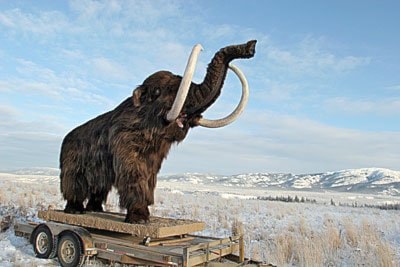Woolly mammoths originated in parts of what is now the Yukon before moving to Siberia — not the other way around, says a new paleontological report.
The study disproves conventional thinking that mammoths evolved in Siberia before coming to North America over the Bering land bridge.
“(Yukoners) can take a point of pride in the fact that woolly mammoths evolved in our backyard,” said Grant Zazula, the Yukon’s resident paleontologist, and a contributor to the recent research.
Separate species of Siberian and North American mammoths may have co-existed for a period, but after the Siberian mammoths died out 40,000 years ago they were replaced by their North American counterparts.
The findings, presented in this month’s issue of Current Biology, were based on genetic evaluation of 160 separate mammoth specimens.
The research involved a team of scientists ranging from Alberta, Alaska, Siberia and even the Netherlands.
Genetic research, a relatively new tool for paleontologists, was critical in the new findings.
“There’s so many previous hypotheses and really strongly held ideas in paleontology … that are just getting shot down because of the genetics now, and it’s really cool to be a part of that,” said Zazula.
“Before the development of genetics, a lot of these ideas about migration and of evolution were really based on very little evidence.
“You had bones, skulls and teeth … but the real story of evolution is really told through genetics,” he said.
While scientists now know where mammoth evolution took place, the next step is to figure out when.
Conventional wisdom holds that mammoths died out approximately 10,000 years ago.
However, select islands in the Bering Sea have recently yielded remains that are only a few thousand years old.
“It will be really cool to see, as we date more specimens and do more work, how recently woolly mammoths were around,” said Zazula.
“Who’s to say they weren’t around 1,000 years ago?” he added.
As Leif Erikson first stepped ashore onto North America, he may very well have shared the continent with the last dying generations of woolly mammoth.
The Yukon retains a reputation as a rich global hotbed of mammoth remains, having furnished the majority of the samples used in the new study.
Zazula reminded Yukoners that every sample is critical to their research, and discoveries such as this could only have occurred with the support of the many Yukoners who regularly donate mammoth specimens.
“To do this kind of genetic work you need huge sample sets … we’re always going to need more samples,” said Zazula.
Indeed, even the Queen has jumped on the mammoth-collecting bandwagon in recent days.
Over the weekend, the remains of a woolly mammoth were uncovered at the Queen’s Balmoral estate in Scotland. The Queen was “very excited” by the find, reported England’s Daily Telegraph.
Buckingham Palace could not be reached for comment before press time.
